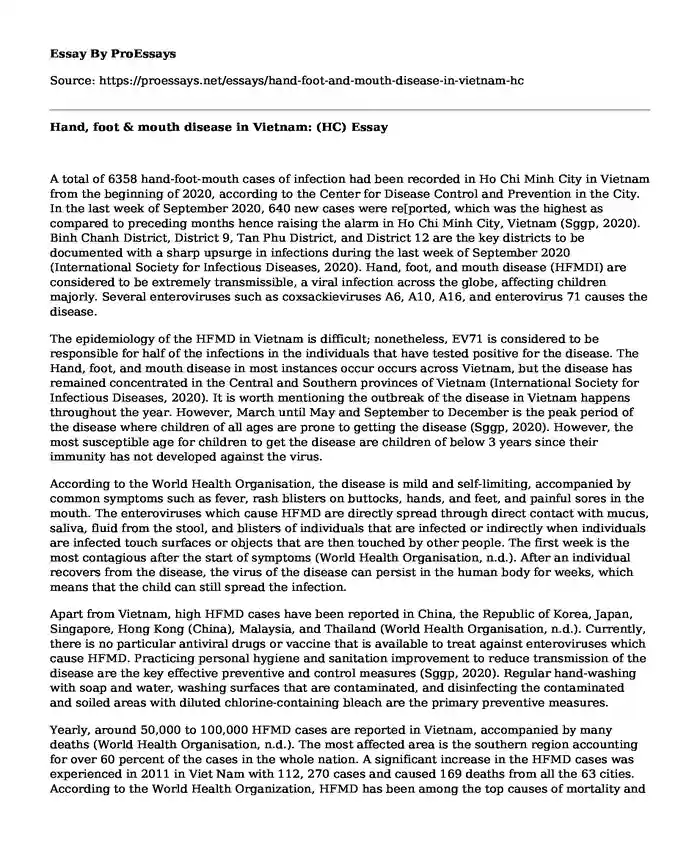A total of 6358 hand-foot-mouth cases of infection had been recorded in Ho Chi Minh City in Vietnam from the beginning of 2020, according to the Center for Disease Control and Prevention in the City. In the last week of September 2020, 640 new cases were re[ported, which was the highest as compared to preceding months hence raising the alarm in Ho Chi Minh City, Vietnam (Sggp, 2020). Binh Chanh District, District 9, Tan Phu District, and District 12 are the key districts to be documented with a sharp upsurge in infections during the last week of September 2020 (International Society for Infectious Diseases, 2020). Hand, foot, and mouth disease (HFMDI) are considered to be extremely transmissible, a viral infection across the globe, affecting children majorly. Several enteroviruses such as coxsackieviruses A6, A10, A16, and enterovirus 71 causes the disease.
The epidemiology of the HFMD in Vietnam is difficult; nonetheless, EV71 is considered to be responsible for half of the infections in the individuals that have tested positive for the disease. The Hand, foot, and mouth disease in most instances occur occurs across Vietnam, but the disease has remained concentrated in the Central and Southern provinces of Vietnam (International Society for Infectious Diseases, 2020). It is worth mentioning the outbreak of the disease in Vietnam happens throughout the year. However, March until May and September to December is the peak period of the disease where children of all ages are prone to getting the disease (Sggp, 2020). However, the most susceptible age for children to get the disease are children of below 3 years since their immunity has not developed against the virus.
According to the World Health Organisation, the disease is mild and self-limiting, accompanied by common symptoms such as fever, rash blisters on buttocks, hands, and feet, and painful sores in the mouth. The enteroviruses which cause HFMD are directly spread through direct contact with mucus, saliva, fluid from the stool, and blisters of individuals that are infected or indirectly when individuals are infected touch surfaces or objects that are then touched by other people. The first week is the most contagious after the start of symptoms (World Health Organisation, n.d.). After an individual recovers from the disease, the virus of the disease can persist in the human body for weeks, which means that the child can still spread the infection.
Apart from Vietnam, high HFMD cases have been reported in China, the Republic of Korea, Japan, Singapore, Hong Kong (China), Malaysia, and Thailand (World Health Organisation, n.d.). Currently, there is no particular antiviral drugs or vaccine that is available to treat against enteroviruses which cause HFMD. Practicing personal hygiene and sanitation improvement to reduce transmission of the disease are the key effective preventive and control measures (Sggp, 2020). Regular hand-washing with soap and water, washing surfaces that are contaminated, and disinfecting the contaminated and soiled areas with diluted chlorine-containing bleach are the primary preventive measures.
Yearly, around 50,000 to 100,000 HFMD cases are reported in Vietnam, accompanied by many deaths (World Health Organisation, n.d.). The most affected area is the southern region accounting for over 60 percent of the cases in the whole nation. A significant increase in the HFMD cases was experienced in 2011 in Viet Nam with 112, 270 cases and caused 169 deaths from all the 63 cities. According to the World Health Organization, HFMD has been among the top causes of mortality and morbidity in Vietnam (World Health Organisation, n.d.).
Conclusion
The places with children such as nurseries and kindergartens are reported to be posing as high-risk transmission areas of the disease. With the beginning of a new academic calendar in the country, the area is expected to experience possible outbreaks in the City. Thus, parents are advised to take their children to nearby medical clinics once their children show symptoms of HFMD.
References
International Society for Infectious Diseases. (2020, October 04). Promed Post – ProMED-mail. Retrieved October 05, 2020, from https://promedmail.org/promed-post/?id=20200530.7392699
Sggp, & SGGP staff writers – Translated by Uyen Phuong. (2020, October 03). Hand-foot-mouth infection cases soar in HCMC. Retrieved October 05, 2020, from https://sggpnews.org.vn/health/handfootmouth-infection-cases-soar-in-hcmc-88723.html
World Health Organisation. (n.d.). Hand, foot, and mouth disease in Viet Nam. Retrieved October 05, 2020, from https://www.who.int/vietnam/health-topics/hand-foot-and-mouth-disease-(hfmd)
Cite this page
Hand, foot & mouth disease in Vietnam: (HC). (2024, Jan 06). Retrieved from https://proessays.net/essays/hand-foot-and-mouth-disease-in-vietnam-hc
If you are the original author of this essay and no longer wish to have it published on the ProEssays website, please click below to request its removal:
- Antibiotic Resistance and Impact on Human Health
- Paper Example on Benefits of Information Health Systems
- Essay on Christian View of Euthanasia
- Management Systems Approach to Health and Safety Essay
- Essay Sample on Digestion: Essential Process for Human Health & Nutrition
- Nursing: Gender and Patient Satisfaction - Essay Sample
- Paper Example on Age-Related Changes: Nutritional Challenges & Health Risks







